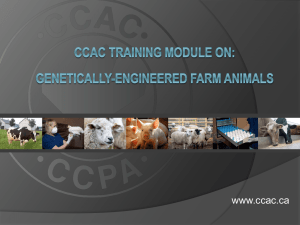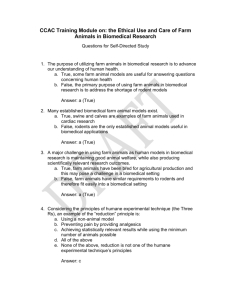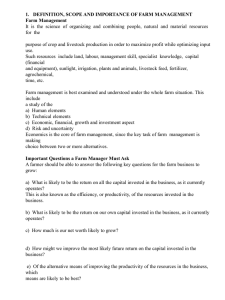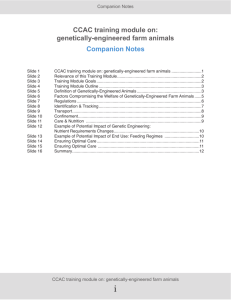Farm Animals in Biomedical Research
advertisement
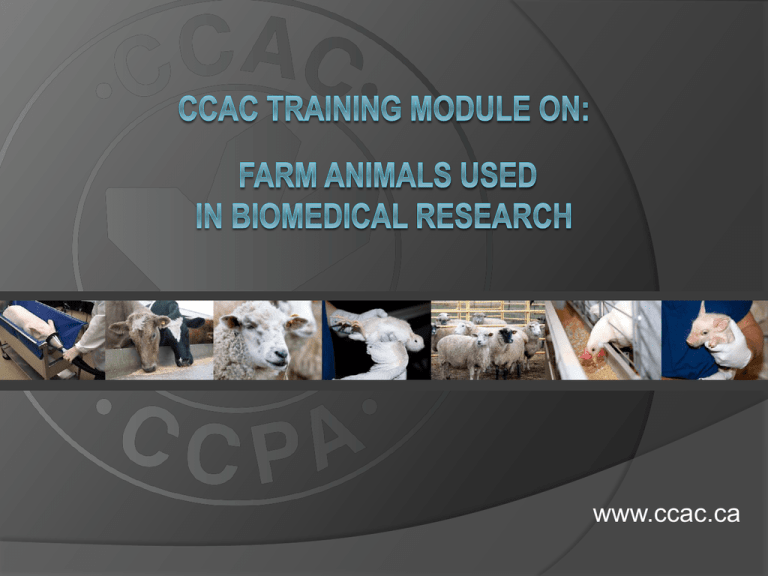
www.ccac.ca This training module is relevant to all animal users working with farm animals used in biomedical research This module covers the following farm animals: dairy and beef cattle sheep goats swine poultry horses farmed wildlife Photo courtesy of Animal Resources Centre, University of Saskatchewan 2 Provide an overview of the special care requirements of farm animals in biomedical research Explain the important considerations relating to the selection of appropriate farm animal models Provide investigators with references and resources for the use of farm animals in biomedical research Basic principles of farm animal welfare, fundamental needs, acquisition, routine handling and specialized procedures and termination of scientific use are covered in the CCAC training module on: the ethical use and care of farm animals in science (2010) 3 Farm animals in biomedical research Special challenges and considerations related to using farm animals in biomedical research Animal model selection Meeting animal needs Facility and disease control considerations Example of biomedical applications: medical devices 4 The purpose of using farm animals in biomedical research is to address questions concerning human health Many applications exist, e.g.,: neurological research development and testing of pharmaceuticals and medical devices reconstructive surgery research medical education Fertilized eggs are used in vaccine development 5 Swine e.g., skin grafts or skin testing, reconstructive surgery Calves e.g., ventricular assist devices Photo courtesy of UBC Animal Welfare Program Chickens e.g., production of antibodies in eggs Sheep e.g., examining perinatal and neonatal development 6 • Agricultural performance and scientific biomedical outcomes may have no relation • Animal selection and management must be flexible, and made on a case-by-case basis Goal: Good animal welfare + Scientifically relevant outcomes 7 Replacement Is it possible to use non-animal models? What is the minimum number of animals needed in order to achieve statistically relevant results? Have replacement and reduction alternatives been considered? Are pain and distress minimized as much as possible? Reduction Refinement See the CCAC training module on: the Three Rs of humane animal experimentation (2003) and the CCAC Three Rs microsite at www.ccac.ca/en/alternatives for further information on the topic of the Three Rs 8 Sentience Lifespan Availability in captivity Tolerance to humans Husbandry and housing requirements Availability of information (anatomy, physiology, behaviour) Suitability to research objectives and experimental conditions Applicability of resulting data to human physiology 9 Farm animals models are very different from rodent models The involvement of a veterinarian is critical in all aspects of biomedical research planning and implementation Animal care personnel must receive appropriate training in the care and handling of the specific species being used 10 Consider growth and life stage in relation to study requirements Adult human models need for physiological, anatomical or biochemical criteria match issues: maturity, size, long-term studies difficult Pediatric models shorter time course to adulthood useful for answering questions in research timeframe 11 Genetic variability farm animals have greater genetic variability than conventional laboratory animals increased variability in treatment response, may require increased number of animals for scientific significance Animal acquisition similar requirements to conventional research animals additional regulations in some cases 12 Understanding the social and behavioural needs of animals is necessary in order to choose an appropriate farm animal model: experimental design should address the infrastructure needed to meet animal needs exercise should be provided every 7 days (minimum) animals should be habituated to handling before study commencement 13 Species-specific husbandry Sanitation and hygiene program to address animal and human health issues dedicated equipment medical management according to standard veterinary practices necropsy facilities address zoo sanitary issues Zoonoses infection control Potential exposure risks are higher than in rodent models particularly important for “cross-over” agents Photo courtesy of the Government of Canada Staff must be informed about the possible routes of disease transmission and exposure, and trained in the use of protective equipment, medical interventions and safety procedures that are to be used to manage the hazard 14 Two types of devices: external: may require animal restraint and confinement internal: require on-going short and long-term assessment strategies Their size makes farm animals good candidates for testing medical devices, e.g.,: ventricular assist devices (cardiovascular research) bone implants (endosseous research) implanted cerebral stimulators (neural research) Photo courtesy of the Government of Canada Induction of anesthesia with a face mask 15 How do in vivo medical devices impact the animal? Effect of device (e.g., failure) Device deployment (e.g., placement inside animal) Device-patient interfaces (e.g., communication with device) Performance instrumentation Animal Welfare (e.g., collecting data) 16 Prior to in vivo, test in vitro to ensure intended use is appropriate for target species devices must be designed in the context of intended use and the target species non-survival, anesthetized, pain-medicated animal could be used during design refinement The testing of medical devices requires careful attention to: potential welfare impacts special care endpoint determination Photo courtesy of the Government of Canada Fully instrumented domestic swine model 17 Protocol should include: device performance reliability biocompatibility device failure and repair strategies Endpoints should: balance the scientific goals and animal welfare detail the procedures needed to handle device failure and malfunction See the CCAC guidelines on: choosing an appropriate endpoint in experiments using animals for research, teaching and testing (1998) and the CCAC training module on: pain, distress and endpoints (2010) for further information 18 Farm animals are useful in some biomedical research, as long as the correct model is used Careful consideration must be given to: balancing animal needs and achieving scientific goals understanding animal welfare impacts of the specific biomedical research conducted Investigators should strive to achieve their scientific goals in line with the best possible animal welfare standards 19
